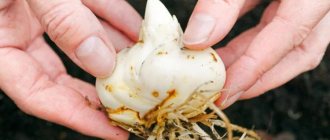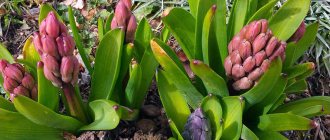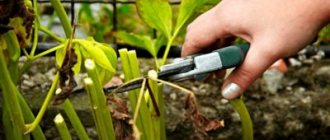Garden lily is a beautiful bulbous perennial. But in order for it to please the gardener with large, bright flowers, we must not forget about proper care for it throughout the year. And the coming autumn is the time to think about the state of your flower garden.
So, what to do with lilies in the fall, what manipulations to carry out on the site? Firstly, it is planting new plants. Secondly, replanting lilies that have already taken over your area for several years. Thirdly, proper autumn care for lilies (watering, fertilizing, pruning) and preparing them for winter.
Let's look at all these procedures in more detail.
What is the need for this procedure?
Any variety of lily can grow in one place for no more than 3-6 years. This is because the earth gradually becomes depleted of minerals, due to the lack of which the plant does not have the opportunity to fully develop.
Lily bushes are replanted every 4-6 years. The need for this manipulation is that the bulbs pull all the nutritional components from the ground, depleting the soil. Because of this, the bush begins to feel a lack of minerals, and it does not have enough strength to form buds.
Often there is a need to replant plants prematurely; this happens if the lilies are constantly sick and stop growing.
How to choose lily bulbs for fall planting
Choosing high-quality planting material is the key to beautiful and lush flowering in the future. It is recommended to select garden lily bulbs according to the following recommendations:
- It must be clean, without traces of mold, rot, or any stains.
- The normal size is at least 3-4 centimeters in diameter. It is not recommended to buy specimens smaller than 2 cm.
- The bottom is solid and has no damage.
- There should be no sprouts on the planting material.
- The roots are healthy, without signs of drying out, rotting, or mold.
- The bulb is dense, the scales fit tightly to it and do not fall apart. But soft, loose, limp or dry specimens should be avoided.
- As for the color of planting material, there are no recommendations, because the shade is influenced by the type and variety of the flower, and not the quality.
Advantages of transplanting in autumn
Transplanting lilies in the fall has a number of advantages:
- the lily bush has managed to fully recover after the summer, it has enough strength to easily move to a new place;
- During the summer period, children managed to form, which can be used to propagate the plant;
- favorable weather - warm, with precipitation, contributes to the rapid adaptation of the bush after its movement.
Lilies should not be replanted in the fall if the cold comes early or the bush blooms late.
To fully adapt, the bulbs need to spend about 4 weeks in a new place before the onset of frost.
The lily is moved only when the dormant period has begun and the bulbs have fully received the necessary nutrition.
When to replant lilies: autumn or spring
The best time to transplant lilies is autumn. The plant has time to take root in the garden and prepare for winter. In the spring, varieties with low winter hardiness are planted, which have to be dug up in the fall and stored at home.
Spring planting is also acceptable. It is carried out after the snow has melted and the soil has warmed up. Work is carried out until the bulb germinates. In the south, the flower is replanted in March, in colder climates - in mid or late April, when the frosts end.
Varieties that can be replanted
In the fall, you can move to another place those lilies that have time to bloom. Plants that continue to open buds in August - early September should not be moved. This applies mainly to oriental hybrids.
The frequency of transplanting lily bushes depends on their type:
- martagons - can grow without changing place for about 8 years;
- Asian - they need to be moved every 2 years;
- tubular varieties - once every 2 years.
It is recommended to replant the remaining representatives of lily species to new places every 4-5 years.
Is it possible to replant lilies during flowering?
It is not recommended to change the place of cultivation when the buds have not yet faded. Transplantation is a strong stress for the plant, which can lead to its death. Flowering takes a lot of energy from the flower, which is not enough for rooting.
Even if the flower takes root in a new bed, it will require a long period of recovery. Therefore, transplantation during the formation of buds is carried out only when absolutely necessary. In other cases, you should wait until the end of flowering.
In summer, it is allowed to transplant Asian varieties: Aeli, Lady Jane, Red Velvet, White Twinkle, Pink Haze, etc. Such plants bloom early and have good hardiness. Before transplanting, flowers and leaves are cut off from plants.
The right time
The first month of autumn is the best time to transplant lilies to a new place in the fall. But the dates may shift slightly, depending on the weather and climatic conditions in different regions.
The specific date you choose depends on your region.
Moscow region
In the Moscow region, replanting is recommended immediately with the onset of autumn.
The daytime temperature should be from +13 °C to +17 °C.
Night frosts are allowed, but short-lived, and the night temperature should not be below -2 °C.
Ural
In the Urals, transplantation is carried out in September. In the southern parts - in October.
Siberia
Given the cold climate of Siberia, transplanting daylilies must be accompanied by mandatory insulation of the flower for the winter.
The transplant takes place in August. But if the weather is favorable, warm, it can be postponed to a few weeks later.
In regions with harsh winters, it is not recommended to leave even frost-resistant plant varieties outside; it is better to dig them up, move them into a pot and leave them in the house until spring.
In Siberia, bulbs are often dug up and stored at home all winter
Central Russia
In central Russia, with a fairly warm autumn, lilies can be moved to a new location in early October, or a few weeks earlier if the weather forecast warns of cold weather.
Preparing to transplant lilies
Before the procedure itself, it is important to pay enough attention to preparation. You should prepare the area where the lilies will grow and treat the bulbs themselves.
Soil preparation
Lilies are very demanding on the structure of the soil. For full development, they need loose, fertile soil with good drainage. Black soil, loamy soil with a high content of sand, or sandy loam soil are optimal. In other cases, the soil composition should be adjusted. So, soil with a high clay content is dug up, adding 10 kg of coarse sand or sand-gravel mixture per 1 sq. m. m.
You should also check and adjust the acidity of the soil. Lilies may require different acidity levels depending on the variety:
- brindle: requires slightly acidic soil (pH no more than 6);
- curly: alkaline or neutral environment (pH 7–7.5);
- tubular: requires an alkaline environment (pH no more than 8);
- oriental lily and hybrids: slightly acidic soil (pH up to 6.5).
You can measure the acidity of the soil using test strips, which are sold in garden stores. Also, the pH level will tell you the nature of the weeds in the area: wheatgrass and shepherd’s purse grow on alkaline and neutral soils, and sedge, horsetail and sorrel on acidic soils.
To increase acidity, compost or rotted pine spruce branches are added to the soil a few weeks before transplanting. To quickly increase acidity, the soil is dug up with the addition of aluminum sulfate. Liming will help reduce acidity: add lime or dolomite flour to the soil.
Processing of planting material
A month after the lilies bloom, the bulbs are dug up and carefully examined. Tubers with signs of disease are thrown away, healthy ones are set aside for further processing. If there are babies on the bulbs, they can be used to propagate lilies. Select babies from 1 cm in diameter.
Healthy tubers are cleaned of dry scales and dried stems. To reduce the risk of disease development, the bulbs are pickled in a fungicide solution. Suitable:
- strong solution of potassium permanganate;
- "Fitosporin";
- "Karbofos";
- antifungal drug "Maxim".
The planting material is immersed in an antibacterial solution for half an hour. Then they dry and begin planting.
Important! If there are mice or shrews in the area, the bulbs should be coated with products with a strong odor. This could be grease, birch tar or Vishnevsky ointment. The pungent smell will repel rodents and preserve the tubers.
Preparation of tools and materials
For transplantation you will need:
- pruning shears to cut off old stems;
- iron spatula for digging holes;
- small rake for loosening.
You also need to prepare sand and sawdust/peat.
Choosing a new location on the site, predecessor plants
Before replanting garden lilies, you need to decide on a new location. It must meet the following criteria:
- wind protection;
- absence of drafts;
- lighting - abundant, but diffused; during the day in the summer heat, direct sunlight should not fall on the bushes;
- location of the site on a hill so that water does not accumulate after watering and heavy rainfall.
It is recommended to place tall bushes near fences or walls of the house so that they have additional protection from strong winds and do not break.
Daylilies should not be planted in places where groundwater flows close to the surface.
To prevent the occurrence of various diseases, daylilies must be planted in the place where plants previously grew that do not have common diseases with lily flowers.
Such predecessors include:
- legumes;
- ornamental cereals;
- annual flowers - carnation, phlox, morning glory;
- zucchini, radishes and cucumbers;
- greenery.
It is forbidden to plant bushes where other bulbous flowers and plants previously grew - tulips, garlic, asters, strawberries, onions.
In cases where it is not possible to maintain correct crop rotation, it is necessary to change the top layer of soil by 25 - 30 cm.
Preparation of planting material
Preparation of planting material involves its sorting and disinfection:
- the dug up onions are cleared of soil;
- the children are carefully examined - damaged areas and areas that show signs of rot are removed;
- sorting - bulbs that have reached a diameter of about 1 cm are suitable for planting;
- healthy children are cleaned of dried scales and stem residues;
- for the purpose of disinfection, the seed material is immersed in a fungicidal solution for 20-30 minutes;
- After disinfection, the babies are laid out to dry.
When the bulbs are dry, they can be planted in open ground. Large bulbous nests can be divided into sections.
Experienced gardeners recommend pouring sand not only at the bottom of the hole, but also enveloping the bulbs in it
To protect children from destruction by shrews and mice, it is recommended to coat them with any product that has a strong, repulsive odor. It could be tar, Vishnevsky ointment, solid oil.
Caring for lilies
Caring for lilies after transplantation is easy. Provided that the soil was fertilized during preparation, this is not necessary until next spring. With the beginning of spring, it is possible to add wood ash or compost. As for watering, it may be necessary if the autumn is warm and without heavy rains; under such conditions it is necessary to clear the soil of weeds.
Early snowfall will provide additional protection from frost for planting. If a snowy winter is not expected, it is better to take care of shelter in advance.
Successful cultivation of lilies consists of a simple scheme, following which the plant will bloom profusely. The main condition is the correct timing for planting and transplanting lilies into open ground. Without proper care, a lily can also bloom, but it will happen much later and less often.
Instructions
Transplantation is not a complicated agrotechnical process that even a novice gardener can do. But you need to work with the plant carefully so as not to damage it.
Digging up bulbs
Before digging up the bulbs, it is recommended to loosen the soil around the bush with a pitchfork. The more lush and lighter the soil, the easier it is to dig up the bulbs.
When to dig up lilies for replanting? You need to pay attention to the roots - they should remain bulbs, and if not completely, then for the most part.
If there are young children, you can propagate the bush with them. If there are no children, it is allowed to divide the onion nest into parts in order to replant the bush.
If tall bushes are planted, before replanting it is necessary to support them so as not to damage the bulbs with pegs later.
Planting bulbs
Planting bulbs is carried out in the following way:
- Preparing the holes - their depth should be such that the onions are covered with earth, the layer thickness of which is approximately 4 cm.
- In the case when the bulb has a decomposed root system, the rhizome in the hole must be straightened.
- Sand is poured into the prepared hole.
- An onion is placed inside the hole. The roots are covered with sand, the onion itself must remain clean.
- The hole is filled with earth, which is slightly compacted.
- A layer of mulch, made from sawdust or pine chips, is placed on top. Mulching will help protect the seed from frost.
Film can be used as additional winter protection. But it is necessary to cover the place where the bulbs are planted only after the temperature drops to -2 °C...-4 °C degrees.
If several bushes are planted nearby, it is necessary to make a distance of approximately 25-30 cm between the holes. The denser the planting, the sooner the bushes will need to be transplanted, which, as they grow, will not have enough space.
Transplant procedure technology
Garden lilies are replanted in accordance with certain agrotechnical rules and requirements. If everything is done correctly, the bulbs will quickly take root, the plants will be strong and healthy, and will bloom luxuriantly and brightly. They can be placed separately from other flowers or combined with them, planted together in flower beds.
Disembarkation scheme
For the successful development of plants, they must be provided with a certain area of nutrition. The distance between the bulbs that needs to be maintained depends on the variety. For example, for bulbs of low-growing varieties it is necessary to leave 8-10 cm, for medium-growing varieties - 10-15 cm, tall ones will have to be planted at intervals of 15-20 cm. When planting in holes, pour a little coarse sand into it, plant the bulb, cover it with soil on top , water and mulch with any plant material or a piece of agrofibre.
Planting depth
For each lily, dig a hole, the depth of which should be equal to triple the diameter of the bulb. This is the best option; with this depth they will feel most comfortable. There is no need to bury it below, nor should it be located too close to the surface of the earth.
Care after transplantation, beginning of flowering
After transplantation, no follow-up care is required as such. It is enough to sprinkle mulch on the ground so that the bulbs do not freeze when the first frosts arrive.
If the winter is snowless, additional shelter for the winter is made using agrofibre, film, leaves. In the spring, as soon as consistently warm weather sets in, the film and other insulation materials must be opened immediately.
When the transplant was carried out without any disturbances, the plant will bloom for the first time in the spring or with the onset of summer. Sometimes bushes begin to bloom after a year.
Beginner flower lovers are better off purchasing ready-made factory fertilizers.
Emergence of seedlings
The beginning of the growing season for plants planted in the fall depends on the type of daylily and the weather. The first shoots of tubular species begin to emerge in March, while in Asian species this process is delayed until May.
After emergence, it is recommended to feed the lily using nitrogen nutritional compounds.
It is forbidden to use manure for fertilizer, as it may contain pathogenic microorganisms. In addition, such organic matter is too heavy for delicate lily flowers.
If a novice gardener cannot understand fertilizers and the frequency of their use, it is better to use purchased products intended for lilies and follow the instructions.
Errors
Despite the ease of transplanting daylilies, novice gardeners often make a number of mistakes, which lead to the fact that the plant in a new place cannot fully develop, and sometimes even dies.
If you follow all agrotechnical measures during transplantation, already at the beginning of summer, the strengthened lily will delight you with abundant color
Common mistakes:
- Improper digging of a bush, when the grower damages the bulbs and their root system with a shovel. It is recommended to dig up lilies with a pitchfork; this significantly reduces the risk of damaging the bulbous nests.
- Neglecting disinfection of the bulbs leads to the fact that the young plant becomes infected with fungal diseases.
- Watering after transplanting. This is the most common mistake. There is no need to water bushes transplanted in autumn. There is enough natural moisture in the air and soil, and additional moisture leads to rotting of the bulbs.
- Premature pruning of bushes and replanting. After the lily has faded, you need to wait about 4-6 weeks. This is necessary so that the bulbs have time to gain the necessary nutritional components, so that they can then easily transfer to a new location.
- Early shelter for the winter. If the weather is still warm, you cannot cover the place where the bulbs are planted. In combination with high humidity, heat from the ground under the shelter creates favorable conditions for the appearance of fungus.
Often, novice gardeners neglect the need to carefully select a place where they can place lilies. If lily bushes in a new area fade or wither too quickly, this may be a sign that groundwater is close to the ground, or the place itself is in a lowland, which is why water is retained there.
Do I need to dig up lilies for the winter?
Not all types of lilies are able to withstand winter frosts. In southern regions with mild winters, the bulbs are left in the soil. In late autumn, flowers are prepared for wintering. If a cold winter is expected, it is recommended to dig up the plants for the winter.
Advice! Tubular varieties freeze even under good cover, so they must be dug up.
Lilies are dug up at certain times:
- LA and Asian hybrids - in the second half of August;
- OT hybrids - at the end of August;
- eastern varieties - in early September.
Lilies are removed from the ground along with their nests, and the stems are cut off. Then the material is inspected, dry flakes are removed and washed with water. Bulbs with traces of damage are discarded, the rest are kept for 20 minutes in a solution of potassium permanganate and dried in the shade.
For storage, prepare a box or bag into which peat is poured. The bulbs are laid on top in rows, and peat is again poured onto them. If there is a lot of planting material, it is laid in rows. Between the lilies there must be a layer of peat.
Important! Lilies are stored in a room with moderate humidity. Dry air leads to dehydration of the bulbs. High humidity leads to mold and plant rotting.
Permissible ambient temperature is from 0 to +5 °C. It is best to choose a dark place: under natural or artificial light, the flower will begin to grow. Future planting material is kept in the refrigerator compartment intended for vegetables. In this case, it is not recommended to put fresh vegetables and fruits there.
A cellar or basement is suitable for storage before transplantation, if the necessary conditions are maintained in the room. An alternative option is to place the planting material in thermal chambers and send it to the balcony or loggia.
During the winter you need to check the condition of the lilies. If dry areas are found, they are sprayed with water. If rotting begins, the bulbs are removed from the peat and kept for 30 minutes in a solution of potassium permanganate. The material is then dried and kept at lower humidity until replanting.











